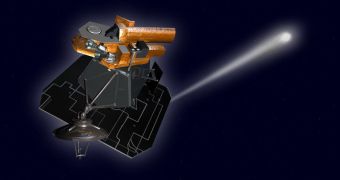The EPOXI mission is finally nearing its targets, mission controllers announced recently, saying that the spacecraft has just performed its 20th orbital correction maneuver successfully.
Thanks to this accomplishment, the spacecraft is now on track towards meeting up with comet Hartley 2. The event is scheduled to take place on November 4.
The EPOXI spacecraft, a project led by experts at the University of Maryland, took off from the Space Launch Complex 17-B at the Cape Canaveral Air Force Station (CCAFS), in Florida, on January 12 2005.
The probe is now some 14.7 million miles (23.6 million kilometers) away from Earth, and has just performed a successful correction maneuver for the 20th time. This is a remarkable achievement in itself.
After performing calculations based on the latest measurements that the spacecraft sent back, mission controllers determined that the point of closest approach will be November 4, 2010, at 10: 02 am EDT (7:02 am PDT).
The latest correction took place on September 29, at around 2 pm EDT (11 am PDT). The engines aboard EPOXI fired for about 60 seconds.
“We are about 23 million miles and 36 days away from our comet. I can't wait to see what Hartley 2 looks like,” says Tim Larson, the project manager for the mission.
He is based at the NASA Jet Propulsion Laboratory (JPL), in Pasadena, California. He explains that the closest the spacecraft will get to the comet is 700 kilometers (435 miles).
The target of the investigations is naturally the structure's nucleus. But the new observations will also be important because they will represent the first time the same space probe is used to image two comets.
“We are imaging the comet every day, and Hartley 2 is proving to be a worthy target for exploration,” argues the principal investigator for EPOXI, University of Maryland in College Park expert Mike A'Hearn.
This mission is managed by the JPL for NASA's Science Mission Directorate, at the agency's Headquarters in Washington DC.
The main contractor for the construction of the spacecraft was awarded to Boulder, Colorado-based Ball Aerospace & Technologies Corp.

 14 DAY TRIAL //
14 DAY TRIAL //